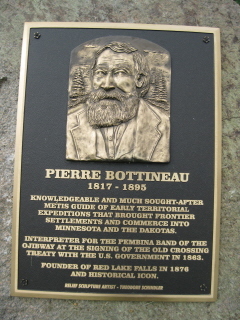Who the Heck Was Pierre Bottineau?
Pierre Bottineau was born around 1817 near Pembina in the Red River region of what is now North Dakota. His paternal ancestors were Huguenots–French Protestants who held to the Reformed tradition of Protestantism–who came to America and settled near Boston. His father was a trapper and explorer in the early-19th century, and his mother was Ojibwe. From them, Bottineau inherited a hardy and adventurous nature that served him well as a scout and voyageur. He was described as being over six feet tall, weighing around 200 pounds, and having piercing black eyes. After his death, a fellow scout described him as having “naturally of manly instincts and gentlemanly deportment, polite, agreeable and of a kindly disposition, and always true to his word and to his fellow men.”
He started his career alongside his father as a small boy hunting and trapping the mighty northwest. As a young teenager, Bottineau made the Selkirk settlement in Canada his headquarters and took his first trip carrying messages for the Hudson’s Bay Company from Selkirk to Prairie du Chien in 1830. After that, he made several trips as a messenger and guide from the Hudson’s Bay Company’s posts in Manitoba to the stations of the American Fur Company in various parts of Minnesota.


Around 1840, Bottineau began calling St. Paul home, though he continued the life of a hunter and voyageur. He often acted as a guide and interpreter for the officers at Fort Snelling due to his fluency in French, English, Dakota, Ojibwe, Cree, Mandan and Winnebago. In 1844, he purchased 160 acres of land near St. Anthony Falls. He continued buying property in the area as his finances allowed and eventually owned more than 700 acres in what is now Minneapolis.
In July 1852, Bottineau was leading a group of speculators through the deep woods to the northwest of Minneapolis. When they stepped out from beneath the trees, Bottineau saw a beautiful prairie sprawled out before them. He decided to create a settlement on the spot he believed was as close to paradise as he’d ever been. He named the settlement Bottineau Prairie–now the town of Osseo–and moved his family there soon after. The following year, he acted as a scout on the first preliminary survey ever made for the Northern Pacific Railway. In his official report of the trip, Governor of the Washington Territory, Isaac I. Stevens, spoke highly as Bottineau as “the man who seemed to have great influence over the voyageurs and Indians.”
Bottineau continued to serve as a surveyor and led settlement parties throughout Minnesota and North Dakota. In 1876, Bottineau was on an expedition with two of his sons–William and Henry–when he was struck again with the beauty of the landscape near the Clearwater River in what is now Red Lake Falls. He and his sons staked a claim there, building a small home and planting a garden. He left his sons to care for the property while he returned to Osseo to gather the rest of his family and move them to the new settlement. While he was away, Henry came down with pneumonia. William did the best he could to nurse him, but Henry died just after his parents returned from Osseo. He was buried by the river and Bottineau erected a huge wooden cross over the grave. Henry’s body was later moved to the old Cyr Cemetery, and more recently, to the permanent Bottineau memorial in St. Joseph’s Cemetery where Bottineau is also buried.


Bottineau’s invaluable service to the exploration and expansion of the United States, as well as the development of Minnesota and North Dakota earned him celebrity status in his time. Upon his retirement, Henry Sibley proposed to the United States Congress in 1879 “to pass a special act for the benefit of granting Pierre Bottineau, pioneer scout and guide, a pension of $50 a month.” It further stated that “his services to the government merit the consideration of Congress.” The pension was granted and guaranteed until his death.
Bottineau died in Red Lake Falls in 1895. Settlements he founded during his life as a frontiersman include Osseo, Maple Grove, Red Lake Falls, and Breckenridge, Minnesota, and Wahpeton, North Dakota. Bottineau County in North Dakota, and its county seat Bottineau are named in his honor. So is the Pierre Bottineau branch library and Bottineau Park in Minneapolis and Bottineau Blvd. in Hennepin County. In Red Lake Falls, appreciation led to the establishment of a permanent memorial to Bottineau in St. Joseph’s Cemetery. The monument is located on a slice of land from which one can see Bottineau’s homestead. Many descendants of Bottineau’s 18 children that lived into adulthood continue to call Minnesota and North Dakota their home.
References:
Petition for Pierre Bottineau, 1879 March.
Jorgensen, Anna Margareth. Life of Pierre Bottineau. 1925
Hallberg, Jane., Sexton, Barbara., and Gustafson, Mary Jane. Pierre Bottineau : a Founder of Osseo, Minnesota : the Kit Carson of Minnesota : the Walking Peace Pipe / Jane Hallberg ; Verification Assistance by Barbara Sexton ; Edited by Mary Jane Gustafson. 1980.
